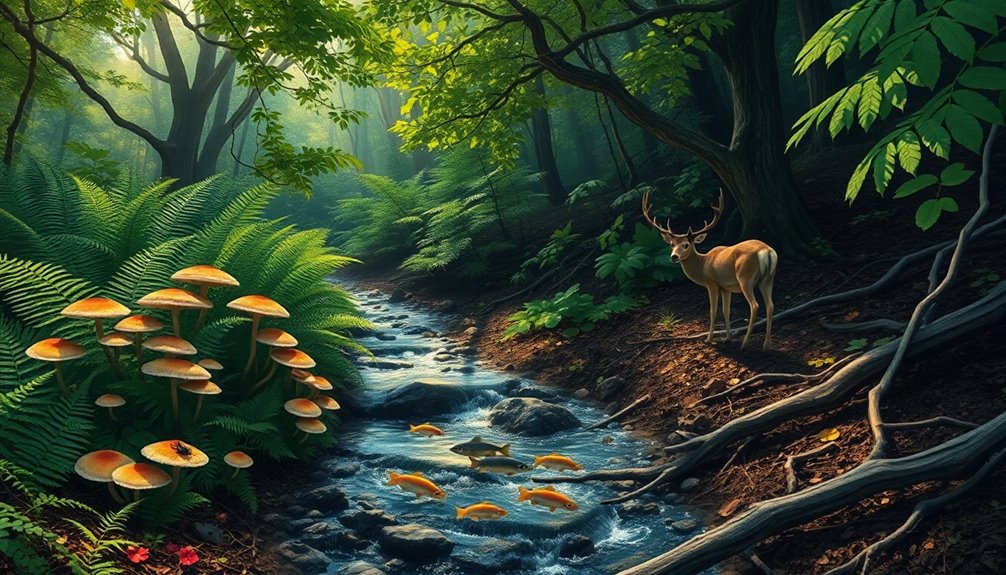Biodiversity is vital for ecosystems as it guarantees stability, enhances resilience, and supports essential processes. A diverse range of species helps ecosystems recover from disturbances, making them more adaptable. High biodiversity also contributes to food security and promotes human health by offering various resources and reducing stress. Furthermore, it plays a significant role in climate change mitigation. Discover how these benefits directly relate to our daily lives and the importance of protecting our natural world.
Key Takeaways
- Biodiversity enhances ecosystem stability and resilience, enabling quick recovery from environmental disturbances and stressors.
- Diverse species provide essential functions, ensuring ecosystem continuity even with species losses through redundancy.
- High biodiversity supports food security by offering varied crop and animal products, combating malnutrition.
- Biodiverse ecosystems are more effective at sequestering carbon and regulating climate, mitigating climate change impacts.
- The presence of diverse species promotes mental well-being and reduces stress, fostering healthier communities.
Understanding Biodiversity

Biodiversity is the lifeblood of our planet, encompassing the vast array of species, genetic variations, and ecosystems that make up our natural world. Understanding biodiversity means recognizing its significance in creating healthy ecosystems.
With over 8 million species on Earth, each plays an essential role in maintaining ecological balance. High biodiversity areas, like coral reefs and rainforests, support unique interactions that are fundamental for processes such as pollination and nutrient cycling. These functions contribute to climate regulation and food production, ensuring human survival.
When biodiversity declines, it threatens the stability of ecosystems, leading to potential collapse and loss of critical resources like clean water and medicines. Protecting biodiversity is key to sustaining our planet's health and our own well-being.
The Role of Biodiversity in Ecosystem Stability

Biodiversity plays an essential role in enhancing ecosystem stability and resilience.
When you have a variety of species working together, they create strong interconnected relationships that help the ecosystem bounce back from disturbances.
This balance not only supports the health of the environment but also guarantees the survival of countless species, including our own.
Ecosystem Resilience Enhancement
Ecosystem stability thrives when a variety of species interact and fulfill different ecological roles, creating a complex web of relationships essential for resilience. High biodiversity enhances ecosystem resilience by ensuring that diverse species can tackle environmental stressors. This genetic diversity means ecosystems can recover more effectively from disturbances like droughts or disease outbreaks. With multiple species performing similar functions, the loss of one doesn't cripple the system.
| Aspect | High Biodiversity | Ecosystem Resilience |
|---|---|---|
| Species Variety | Multiple species present | Redundancy in functions |
| Recovery from Disturbance | Quick recovery | Adaptation to stress |
| Nutrient Cycling | Efficient cycling | Enhanced ecosystem health |
| Genetic Diversity | Broader genetic pool | Greater adaptability |
| Ecosystem Health | Stable and productive | Sustained services |
Interconnected Species Relationships
A rich tapestry of species interactions creates a foundation for ecosystem stability, where each organism plays a unique role. Biodiversity is essential here; it maintains a balance among interconnected species, ensuring the overall health of ecosystems.
In complex environments like coral reefs and rainforests, higher species diversity enhances resilience against threats such as climate change and diseases. When key species decline, like sea otters, it disrupts food webs and results in harmful overpopulation, as seen with sea urchins damaging kelp forests.
Additionally, diverse genetic codes within populations improve adaptability, increasing survival rates during environmental crises. Ecosystems rich in biodiversity are better able to recover from disturbances, drawing on a wider array of species to restore balance and function.
Biodiversity and Human Health

While you may not realize it, the variety of life forms around us plays an essential role in maintaining human health. Biodiversity supports ecosystems that we rely on for food, enhancing both nutrition and food security.
Communities with high biodiversity are better equipped to combat malnutrition, as diverse ecosystems provide a range of crops and animal products. Furthermore, exposure to nature improves mental well-being, reducing stress and promoting happiness.
Curiously, around 70% of emerging viral diseases originate from animals, underscoring how humans depend on biodiversity to prevent zoonotic diseases. By preserving diverse ecosystems, you not only safeguard your health but also contribute to the overall resilience of your community.
Healthy ecosystems foster healthier lives for everyone.
Economic Benefits of Biodiversity

Biodiversity plays an essential role in supporting sustainable business opportunities and resource-based industries.
When you consider that healthy ecosystems are important for pollination and food security, the economic implications become clear.
Sustainable Business Opportunities
Recognizing the economic significance of biodiversity can open up a wealth of sustainable business opportunities. Approximately 40% of the global economy relies on biological resources, highlighting how ecosystems provide essential services. Investing in natural resources and conservation efforts could generate between US$ 2 trillion and US$ 6 trillion by 2050. Furthermore, the stability of food systems hinges on biodiversity, as around 75% of global food crops depend on pollination, which has a staggering economic value of US$ 235 billion. Additionally, understanding Cost of Living Adjustments in the context of biodiversity can help businesses plan for the long-term impacts of environmental changes on economic stability.
| Opportunity | Economic Impact | Importance |
|---|---|---|
| Biodiversity Conservation | US$ 2-6 trillion potential | Supports sustainable industries |
| Pollinator Protection | US$ 235 billion for crops | Enhances agricultural productivity |
| Ecosystem Services | US$ 338 billion loss risk | Maintains natural resource availability |
| Sustainable Practices | Boosts resilience against change | guarantees long-term economic stability |
Resource-Based Industry Support
As ecosystems thrive, they directly bolster resource-based industries that depend on them for raw materials, food, and other essential services.
Biodiversity plays a vital role in the global economy, supporting various sectors, including:
- Agricultural Sector: 75% of global food crops rely on animal and insect pollination, valued at around $235 billion annually.
- Fishing Industry: Sustainable marine protected areas can enhance fish catches by up to 20%, benefiting local economies.
- Economic Stability: Loss of biodiversity could cost industries up to $338 billion each year due to reduced availability of ecosystem services.
- Investment Opportunities: Conserving biodiversity can yield $2 trillion to $6 trillion in sustainable business prospects by 2050.
Pollination and Food Security
While you might not think about it daily, pollinators like bees and butterflies are essential for ensuring food security. They're responsible for pollinating about 75% of global food crops, which translates to agricultural products worth around $235 billion annually. The decline of these pollinators threatens our food supply and prices. Additionally, a lack of emergency fund for farmers can exacerbate challenges when facing crop failures due to inadequate pollination.
| Impact of Biodiversity on Food Security | Benefits |
|---|---|
| Pollination Efficiency | Increases crop yields |
| Crop Diversity | Enhances dietary resilience |
| Healthy Ecosystems | Supports stable farming income |
Biodiversity's Contribution to Climate Change Mitigation

Biodiversity plays an essential role in mitigating climate change by enhancing the ability of ecosystems to sequester and store carbon. By protecting diverse ecosystems, you help reduce greenhouse gas emissions and support essential ecosystem services.
Here are some key contributions of biodiversity to climate change mitigation:
- Carbon Sequestration: Diverse habitats, like mangroves and peatlands, store considerably more carbon than mono-cultured environments.
- Resilience Against Habitat Loss: Biodiverse ecosystems are better equipped to withstand climate change impacts.
- Reduction of Deforestation: Maintaining diverse landscapes helps protect against habitat loss, which is responsible for 11% of global emissions.
- Regulation of Natural Processes: Biodiversity improves the water cycle and soil health, further contributing to climate stability.
Embracing biodiversity is essential for a sustainable future.
Cultural Significance of Biodiversity

How does biodiversity shape our cultures and identities? Biodiversity enriches cultural practices, especially among Indigenous communities, who rely on diverse species for their customs and spiritual beliefs. This intricate relationship fosters unique identities tied to ecosystems. However, biodiversity loss threatens these cultural narratives, erasing history and diminishing the value of biodiversity.
| Cultural Aspect | Connection to Biodiversity |
|---|---|
| Traditions | Reliance on diverse species |
| Art and Music | Inspiration from nature |
| Spiritual Practices | Unique ecosystems hold significance |
| Traditional Knowledge | Sustainable resource management |
| Community Identity | Sense of belonging through nature |
Protecting biodiversity is essential not just ecologically but also culturally, as it safeguards the very essence of who we are.
Threats Facing Biodiversity

Cultural identities are deeply intertwined with the natural world, but this connection is increasingly at risk due to various threats facing biodiversity. These threats can lead to significant loss of biodiversity, impacting ecosystems and communities.
Here are some key challenges:
- Habitat destruction: Urbanization, agriculture, and deforestation fragment ecosystems, endangering species.
- Climate change: Altered habitats and species distributions threaten one million species with extinction within decades.
- Pollution: Industrial and agricultural waste degrades habitats, harming numerous species.
- Invasive species: These organisms outcompete native species, disrupting local ecosystems.
Additionally, overexploitation of resources, like overfishing and illegal wildlife trade, exacerbates these issues.
Addressing these threats is essential for preserving biodiversity and ensuring a healthier planet for future generations.
Strategies for Biodiversity Conservation

While the threats to biodiversity are significant, implementing effective conservation strategies offers a pathway to protect and restore ecosystems.
Establishing protected areas and reserves is essential, as these sites safeguard critical habitats and species from human activities. Community-based partnerships enhance these efforts by integrating local knowledge and promoting stewardship, ensuring that both ecosystems and communities thrive.
Restoration efforts, like reforestation and wetland rehabilitation, boost ecosystem resilience and help reverse biodiversity loss. Monitoring and controlling invasive species is fundamental to protect native biodiversity, preventing disruptions to local ecosystems.
Additionally, adopting sustainable agricultural practices balances food production with conservation, mitigating habitat destruction and promoting healthier ecosystems. Healthy ecosystems provide essential services, such as clean air and water purification, which are vital for both humans and wildlife.
Engaging Communities in Biodiversity Efforts

Building on effective conservation strategies, engaging communities in biodiversity efforts is essential for fostering a deeper connection between people and their local ecosystems.
When you actively participate, you help enhance local conservation initiatives and habitat restoration projects.
Here are some key ways to get involved:
- Volunteer for habitat restoration and species monitoring.
- Share local knowledge to improve conservation strategies.
- Participate in education programs to raise awareness in schools and communities.
- Advocate for environmental protection by joining community-based partnerships.
Frequently Asked Questions
Why Is Biodiversity Important for the Ecosystem?
Biodiversity is essential for the ecosystem because it helps maintain balance and stability.
When you have a variety of species, they interact in ways that support each other, ensuring resources are used efficiently. This diversity allows ecosystems to recover from stressors like climate change and disease more effectively.
Plus, you rely on these ecosystems for essential services like clean water and pollination, which are critical for your survival and overall well-being.
What Are the 5 Benefits of Biodiversity?
Biodiversity offers you numerous benefits. First, it boosts ecosystem stability, helping environments resist changes and recover from stress.
Second, it supports food security through pollination, crucial for crops.
Third, diverse ecosystems provide essential services like clean water and air.
Fourth, genetic diversity enhances species' adaptability and resilience to disease.
Finally, it strengthens economic stability, as many industries depend on biological resources.
Embracing biodiversity helps guarantee a healthier planet for everyone.
What Are the Benefits of Diversity in the Ecosystem?
Diversity directs dynamic developments in ecosystems.
When you embrace biodiversity, you enhance resilience, allowing ecosystems to bounce back from stressors like droughts or disease. Rich, varied environments support a splendid array of species interactions, leading to stability and productivity.
You'll enjoy crucial services like pollination, nutrient cycling, and water purification, which are essential for your health and food security.
Plus, diverse ecosystems help regulate climate, acting as natural shields against climate change impacts.
Why Is Biodiversity Important to the Ecosystem Quizlet?
Biodiversity's crucial for the ecosystem because it guarantees resilience and stability. When you have a wide variety of species, the ecosystem can bounce back from disturbances better.
You rely on diverse organisms for essential services like pollination and clean water. Without biodiversity, these services decline, leading to food insecurity and economic losses.
Conclusion
In the grand tapestry of life, biodiversity weaves threads of stability, health, and prosperity. Without it, ecosystems falter, economies shrink, and our well-being hangs in the balance. Yet, as challenges loom, the fate of our planet rests in our hands. Will you join the fight to preserve these essential connections, or will we watch as the richness of life slips away? The choice is yours, and time is ticking. Embrace biodiversity, and safeguard our future.









